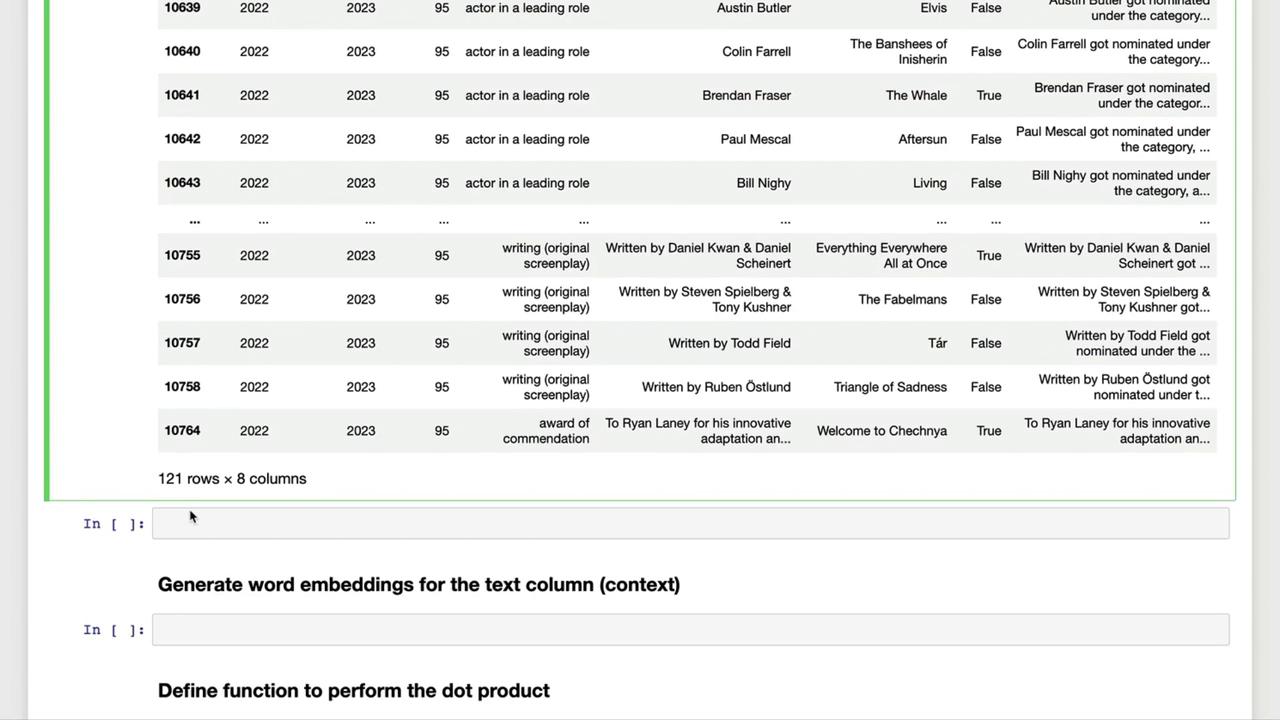Mastering Generative AI with OpenAI
Using Word Embeddings For Dynamic Context
Demo Building Dynamic Context with Custom Data Part 1
In this tutorial, we’ll create a dynamic context for a chatbot by enriching prompts with custom data. We’re using the “Oscar Award, 1927 – 2023” dataset from Kaggle, which includes every nominee and winner by year, ceremony number, category, nominee name, film, and winner status.

1. Environment Setup
First, install dependencies and configure your API key.
pip install pandas numpy openai
Note
Make sure your OPENAI_API_KEY is set in the environment:
export OPENAI_API_KEY="your_api_key_here"
Then, load the Python modules and define helper functions:
import os
import pandas as pd
import numpy as np
import openai
# Load API key
openai.api_key = os.getenv("OPENAI_API_KEY")
Helper Functions
def text_embedding(text) -> list[float]:
"""
Generate embeddings using OpenAI.
"""
response = openai.Embedding.create(
model="text-embedding-ada-002",
input=text
)
return response["data"][0]["embedding"]
def get_word_completion(prompt: str) -> str:
"""
Query GPT-3.5 Turbo for Oscar-related questions.
"""
messages = [
{"role": "system", "content": "You answer questions about the 95th Oscar awards."},
{"role": "user", "content": prompt},
]
response = openai.ChatCompletion.create(
model="gpt-3.5-turbo",
messages=messages,
max_tokens=3000,
n=1
)
return response.choices[0].message.content
2. Loading and Preprocessing the Oscar Dataset
The lab environment already includes data/oscars.csv. Let’s read and trim it:
# Load the dataset
df = pd.read_csv("data/oscars.csv")
df.head()
We focus only on the 2023 ceremony, remove missing film entries, and standardize categories to lowercase.
| Step | Operation | Code Example |
|---|---|---|
| Filter by year | Keep only 2023 ceremony | df = df[df["year_ceremony"] == 2023] |
| Drop missing films | Remove rows where film is null | df = df.dropna(subset=["film"]) |
| Normalize category | Lowercase all category names | df["category"] = df["category"].str.lower() |
# 1. Keep only the 2023 ceremony
df = df[df["year_ceremony"] == 2023]
# 2. Remove entries with no film listed
df = df.dropna(subset=["film"])
# 3. Convert category names to lowercase
df["category"] = df["category"].str.lower()
print(df.shape) # Expect (121, 7)
3. Creating Dynamic Context Sentences
Next, we generate a self-contained sentence for each nomination, combining name, category, film title, and win status.
def make_context(row) -> str:
status = "and won the award" if row["winner"] else "but did not win"
return (
f"{row['name']} got nominated under the category {row['category']} "
f"for the film {row['film']} {status}"
)
df["text"] = df.apply(make_context, axis=1)
df.head(3)

Example Context Sentences
# Example entry #12
print(df["text"].iloc[11])
# Ana de Armas got nominated under the category actress in a leading role
# Example entry #101
print(df["text"].iloc[100])
# Viktor Prášil, Frank Kruse, Markus Stemler, Lars Ginzel and Stefan Korte
# got nominated under the category sound for the film All Quiet on the Western Front
# but did not win
4. Next Steps
With the text column in place, you can now:
- Generate embeddings for each sentence
- Compute similarity scores via dot-product matching
- Build dynamic prompts by selecting the most relevant contexts
In Part 2, we’ll dive into OpenAI Embeddings and similarity matching to power intelligent chatbot responses.
Links and References
Watch Video
Watch video content